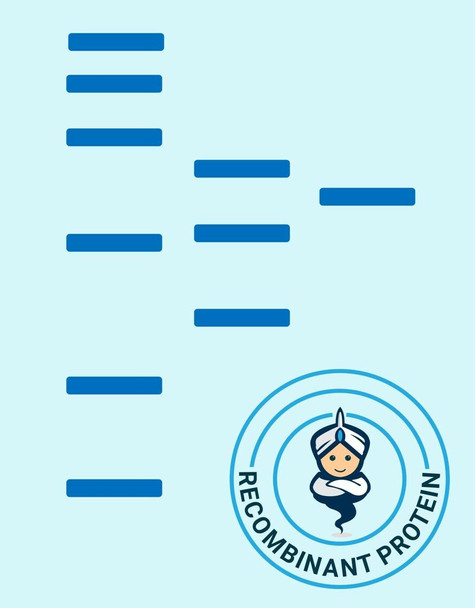Description
| Product Name: | Human KISS1 Recombinant Protein |
| Product Code: | RPPB3792 |
| Size: | 10µg |
| Species: | Human |
| Target: | KISS1 |
| Synonyms: | Kisspeptin-1, KISS-1, METASTIN, Metastasis-suppressor KiSS-1, KISS1, MGC39258. |
| Source: | Escherichia Coli |
| Physical Appearance: | Sterile Filtered colorless solution. |
| Formulation: | The protein solution (1mg/ml) contains 20mM Tris-HCl pH-8, 1mM DTT & 10% glycerol. |
| Stability: | Store at 4°C if entire vial will be used within 2-4 weeks. Store, frozen at -20°C for longer periods of time.�For long term storage it is recommended to add a carrier protein (0.1% HSA or BSA).Please prevent freeze-thaw cycles. |
| Purity: | Greater than 90.0% as determined by SDS-PAGE. |
| Amino Acid Sequence: | MEPLEKVASV GNSRPTGQQL ESLGLLAPGE QSLPCTERKP AATARLSRRG TSLSPPPESS GSPQQPGLSA PHSRQIPAPQ GAVLVQREKD LPNYNWNSFG LRFGKREAAP GNHGRSAGRG |
KISS1 is a metastasis suppressor protein that suppresses metastases of melanomas and breast carcinomas without affecting tumorigenicity.KISS1 functions to inhibit chemotaxis and invasion, attenuating metastasis in malignant melanomas. KISS1 is involved in the regulation of cell-matrix adhesion. KISS1 plays a role in cytoskeletal reorganization. A polymorphism in the terminal exon of KISS1 mRNA results in two protein isoforms. Expression of KiSS1 is localized to specific regions of the hypothalamus in numerous species and is regulated by gonadal steroids and across the estrous cycle..KISS1 generates a c-terminally amidated peptide, metastin which functions as the endogenous ligand of the g-protein coupled receptor gpr54. Activation of the receptor inhibits cell proliferation and cell migration, key characteristics of tumor metastasis.
KISS1 Human Recombinant produced in E.Coli is a single, non-glycosylated polypeptide chain containing 120 amino acids (20-138) and having a molecular mass of 12.6 Dalton. The KISS1 is purified by proprietary chromatographic techniques.
| UniProt Protein Function: | KiSS-1: Metastasis suppressor protein in malignant melanomas and in some breast cancers. May regulate events downstream of cell- matrix adhesion, perhaps involving cytoskeletal reorganization. Generates a C-terminally amidated peptide, metastin which functions as the endogenous ligand of the G-protein coupled receptor GPR54. Activation of the receptor inhibits cell proliferation and cell migration, key characteristics of tumor metastasis. Kp-10 is a decapeptide derived from the primary translation product, isolated in conditioned medium of first trimester trophoblast. Kp-10, but not other kisspeptins, increased intracellular Ca(2+) levels in isolated first trimester trophoblasts. Kp-10 is a paracrine/endocrine regulator in fine- tuning trophoblast invasion generated by the trophoblast itself. The receptor is also essential for normal gonadotropin-released hormone physiology and for puberty. The hypothalamic KiSS1/GPR54 system is a pivotal factor in central regulation of the gonadotropic axis at puberty and in adulthood. Belongs to the KISS1 family. |
| UniProt Protein Details: | Protein type:Secreted; Cell adhesion; Secreted, signal peptide Chromosomal Location of Human Ortholog: 1q32 Cellular Component: extracellular region Molecular Function:protein binding Biological Process: cytoskeleton organization and biogenesis Disease: Hypogonadotropic Hypogonadism 13 With Or Without Anosmia |
| NCBI Summary: | This gene is a metastasis suppressor gene that suppresses metastases of melanomas and breast carcinomas without affecting tumorigenicity. The encoded protein may inhibit chemotaxis and invasion and thereby attenuate metastasis in malignant melanomas. Studies suggest a putative role in the regulation of events downstream of cell-matrix adhesion, perhaps involving cytoskeletal reorganization. A protein product of this gene, kisspeptin, stimulates gonadotropin-releasing hormone (GnRH)-induced gonadotropin secretion and regulates the pubertal activation of GnRH nuerons. A polymorphism in the terminal exon of this mRNA results in two protein isoforms. An adenosine present at the polymorphic site represents the third position in a stop codon. When the adenosine is absent, a downstream stop codon is utilized and the encoded protein extends for an additional seven amino acid residues. [provided by RefSeq, Mar 2012] |
| UniProt Code: | Q15726 |
| NCBI GenInfo Identifier: | 292495092 |
| NCBI Gene ID: | 3814 |
| NCBI Accession: | Q15726.4 |
| UniProt Related Accession: | Q15726 |
| Molecular Weight: | |
| NCBI Full Name: | Metastasis-suppressor KiSS-1 |
| NCBI Synonym Full Names: | KiSS-1 metastasis suppressor |
| NCBI Official Symbol: | KISS1�� |
| NCBI Official Synonym Symbols: | HH13; KiSS-1�� |
| NCBI Protein Information: | metastasis-suppressor KiSS-1 |
| UniProt Protein Name: | Metastasis-suppressor KiSS-1 |
| UniProt Synonym Protein Names: | Kisspeptin-1Cleaved into the following 4 chains:MetastinAlternative name(s):Kisspeptin-54 |
| Protein Family: | Metastasis-suppressor |
| UniProt Gene Name: | KISS1�� |
| UniProt Entry Name: | KISS1_HUMAN |










